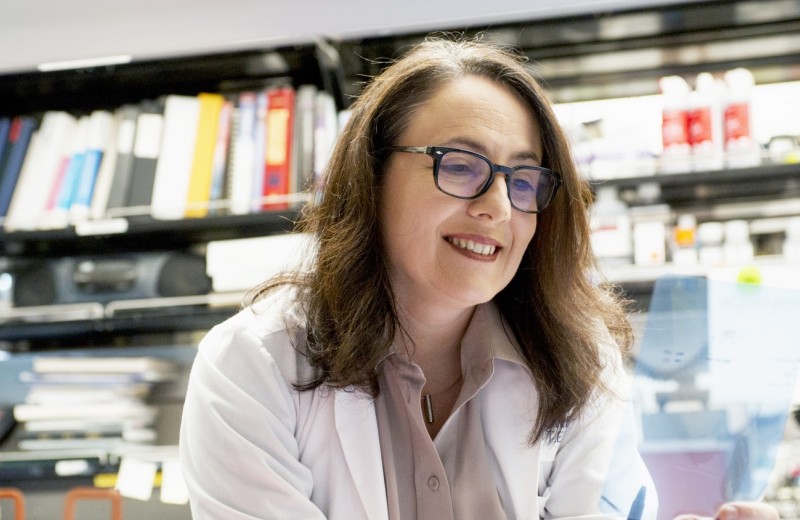Gladstone NOW: The Campaign Join Us on the Journey✕

SAN FRANCISCO, CA—April 26, 2012—Scientists at the Gladstone Institutes have unraveled a process by which depletion of a specific protein in the brain contributes to the memory problems associated with Alzheimer's disease. These findings provide insights into the disease's development and may lead to new therapies that could benefit the millions of people worldwide suffering from Alzheimer's and other devastating neurological disorders.
The study, led by Gladstone Investigator Jorge J. Palop, PhD, revealed that low levels of a protein, called Nav1.1, disrupt the electrical activity between brain cells. Such activity is crucial for healthy brain function and memory. Indeed, the researchers found that restoring Nav1.1 levels in mice that were genetically modified to mimic key aspects of Alzheimer's disease (AD-mice) improved learning and memory functions and increased their lifespan. Their findings are featured on the cover of the April 27 issue of Cell, available online today.
“It is estimated that more than 30 million people worldwide suffer from Alzheimer's disease and that number is expected to rise dramatically in the near future,” said Lennart Mucke, MD, who directs neurological research at Gladstone, an independent and nonprofit biomedical-research organization. “This research improves our understanding of the biological processes that underlie cognitive dysfunction in this disease and could open the door for new therapeutic interventions.”
The researchers' findings suggest that Nav1.1 levels in special regulatory nerve cells called parvalbumin cells, or PV cells, are essential to generate healthy brain-wave activity—and that problems in this process contribute to cognitive decline in AD-mice and possibly in patients with Alzheimer's.
In the brain, neurons form highly interconnected networks, using chemical and electrical signals to communicate with each other. The researchers investigated whether this communication between neurons is disrupted in AD-mice, and if so, how this may affect the symptoms of Alzheimer's disease.
To study this, they performed electroencephalogram (EEG) recordings—a technique that detects abnormalities in the brain's electrical waves such as those found in patients with epilepsy. They found that similar abnormalities emerged during periods of reduced gamma-wave oscillations—a type of brain wave that is crucial to regulating learning and memory.
“Like a conductor in an orchestra, PV cells regulate brain rhythms by precisely controlling excitatory brain activity,” said Laure Verret, PhD, postdoctoral fellow and lead author. “We found that PV cells in patients with Alzheimer's and in AD-mice have low levels of the protein Nav1.1—likely contributing to PV cell dysfunction. As a consequence, AD-mice had abnormal brain rhythms. By restoring Nav1.1 levels, we were able to re-establish normal brain function.”
Indeed, the scientists found that increasing Nav1.1 levels in PV cells improves brain wave activity, learning, memory and survival rates in AD-mice.
“Enhancing Nav1.1 activity, and consequently improving PV cell function, may help in the treatment of Alzheimer's disease and other neurological disorders associated with gamma-wave alterations and cognitive impairments such as epilepsy, autism and schizophrenia,” said Dr. Palop, who is also an assistant professor of neurology at the University of California, San Francisco, with which Gladstone is affiliated. “These findings may allow us to develop therapies to help patients with these devastating diseases.”
Other scientists who participated in this research at Gladstone include Giao Hang, PhD, Kaitlyn Ho, Nino Devidze, PhD, and Anatol Kreitzer, PhD. Funding was provided by a variety of sources, including the National Institutes of Health, the Stephen D. Bechtel, Jr. Foundation, the Philippe Foundation and the Pew and McKnight Foundations.
About the Gladstone Institutes
Gladstone is an independent and nonprofit biomedical-research organization dedicated to accelerating the pace of scientific discovery and innovation to prevent, treat and cure cardiovascular, viral and neurological diseases. Gladstone is affiliated with the University of California, San Francisco.
Support Discovery Science
Your gift to Gladstone will allow our researchers to pursue high-quality science, focus on disease, and train the next generation of scientific thought leaders.
Science in Seconds | The Thinking Microscope: Research Powered by an AI Brain
Science in Seconds | The Thinking Microscope: Research Powered by an AI Brain
In this video, Steve Finkbeiner and Jeremy Linsley showcase Gladstone’s groundbreaking “thinking microscope”—an AI-powered system that can design, conduct, and analyze experiments autonomously to uncover new insights into diseases like Alzheimer’s, Parkinson’s, and ALS.
Gladstone Experts ALS Alzheimer’s Disease Parkinson’s Disease Neurological Disease Finkbeiner Lab AI Big DataKaterina Akassoglou Receives Zenith Fellows Award to Advance Alzheimer’s Research
Katerina Akassoglou Receives Zenith Fellows Award to Advance Alzheimer’s Research
Akassoglou has opened doors to understanding how the blood protein fibrin is involved in Alzheimer’s and other neurodegenerative diseases.
Awards News Release Alzheimer’s Disease Center for Neurovascular Brain Immunology Akassoglou LabMeet Gladstone: Oscar Yip
Meet Gladstone: Oscar Yip
Oscar Yip is advancing Alzheimer’s research in Yadong Huang’s lab at Gladstone while drawing inspiration from his family, community, and his broader goal of helping patients.
Graduate Students and Postdocs Profile Alzheimer’s Disease



